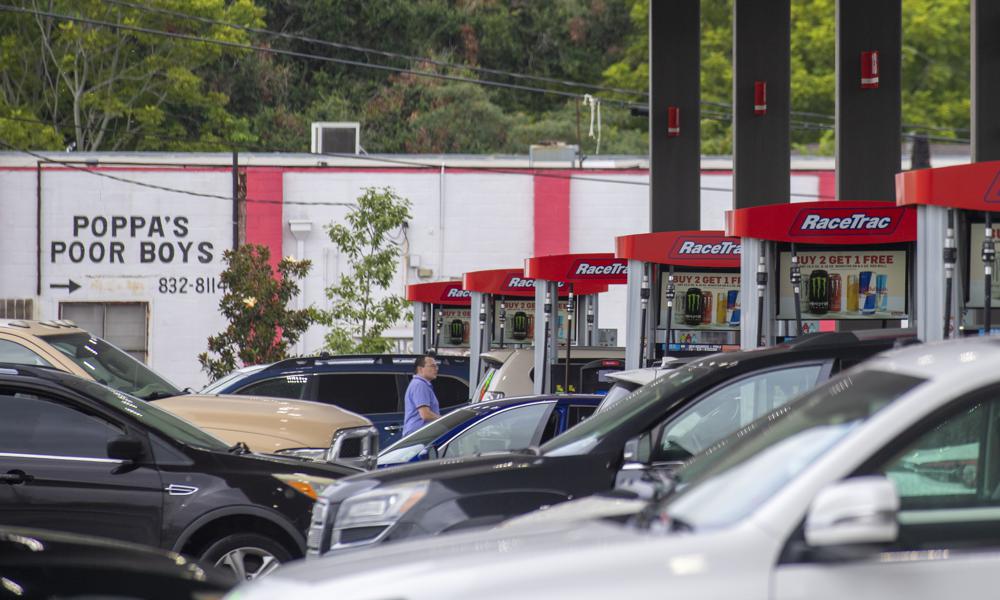
NEW ORLEANS (AP) — Hurricane Ida struck Cuba on Friday and threatened to slam into Louisiana with devastating force over the weekend, prompting New Orleans’ mayor to order everyone outside the protection of the city’s levees to evacuate.
Ida intensified rapidly Friday from a tropical storm to a hurricane with top winds of 80 mph (128 kph) as it crossed western Cuba. The National Hurricane Center predicted it would strengthen into an extremely dangerous Category 4 hurricane, with top winds of 140 mph (225 kph) before making landfall along the U.S. Gulf Coast late Sunday.
“This will be a life-altering storm for those who aren’t prepared,” National Weather Service meteorologist Benjamin Schott said during a Friday news conference with Louisiana Gov. John Bell Edwards.
The governor urged residents to quickly prepare, saying: “By nightfall tomorrow night, you need to be where you intend to be to ride out the storm.”
Residents along Louisiana’s coast braced for Ida to arrive on the exact date Hurricane Katrina devastated a large swath of the Gulf Coast exactly 16 years earlier. Capt. Ross Eichorn, a fishing guide on the coast about 70 miles (112 kilometers) southwest of New Orleans, said he fears warm Gulf waters will “make a monster” out of Ida.
A hurricane warning was issued for most of the Louisiana coast from Intracoastal City to the mouth of the Pearl River. A tropical storm warning was extended to the Mississippi-Alabama line.
New Orleans Mayor LaToya Cantrell ordered the evacuation of everyone living outside the levee system that protects the area from flooding. She did not say how many people lived there, but urged residents with medical conditions and other special needs to get out early.
Officials warned they plan to close floodgates Saturday afternoon on two highways near New Orleans, increasing the sense of urgency for those planning to flee.
Officials decided against evacuating New Orleans hospitals. There’s little room for their patients elsewhere, with hospitals from Texas to Florida already reeling from a spike in coronavirus patients, said Dr. Jennifer Avengo, the city’s health director.
President Joe Biden approved a federal emergency declaration for Louisiana ahead of the storm. White House press secretary Jen Psaki said FEMA plans to send nearly 150 medical personnel and almost 50 ambulances to the Gulf Coast to assist strained hospitals.
Ida made its first landfall Friday afternoon on Cuba’s southern Isle of Youth. The Cuban government issued a hurricane warning for its westernmost provinces, where forecasters said as much as 20 inches (50 centimeters) of rain could fall in places, possibly unleashing deadly flash floods and mudslides.
An even greater danger will then begin over the Gulf, where forecasts were aligned in predicting Ida will strengthen very quickly into a major hurricane, reaching 120 mph (193 kph) before landfall in the Mississippi River delta late Sunday, the hurricane center said.
If that forecast holds true, Ida would hit on the 16th anniversary of Katrina’s landfall as a Category 3 storm with 125 mph (201 kph) winds near the riverside community of Buras in Plaquemines Parish, just down the Mississippi from New Orleans.
Katrina is blamed for an estimated 1,800 deaths from the central Louisiana coast to around the Mississippi-Alabama state line. A massive storm surge scoured the shores and wiped houses off the map. In New Orleans, failures of federal levees led to catastrophic flooding. Water covered 80% of the city and many homes were swamped to the rooftops. Some victims drowned in their attics. The Superdome and New Orleans Convention Center became scenes of sweltering misery as tens of thousands were stranded without power or running water.
Memories of Katrina still haunt many who scrambled to prepare for Ida on Friday, lining up for groceries, gas and ice, as well as sandbags that the city was offering.
Traffic snarled at entrances to a New Orleans Costco, where dozens of cars were backed up at the gas pumps and shoppers wheeled out carts stacked with cases of bottled water and other essentials.
Retired police officer Wondell Smith, who worked on the police force when Katrina hit, said he and his family were planning to stay, but were also getting ready to head farther inland if the forecasts worsened. He loaded water, bread and sandwich meat into his SUV.
“I know what that looks like,” Smith said, referring to the potential devastation. “This is my first time being home in 34 years of service,” he added. “And I want to be prepared.”
Saturday’s preseason NFL game between the Arizona Cardinals and the Saints at the Superdome was first moved up seven hours to avoid the weather, and then canceled altogether.
The hurricane center predicted the peak storm surge could reach 10 feet to 15 feet (3 to 4.5 meters) along with Louisiana coast, with a possible surge of 7 to 11 feet (2.1 to 3.4 meters) in the New Orleans area.
“Being east of this storm’s track is not ideal,” said Collin Arnold, New Orleans’ director of homeland security and emergency preparedness. “We’re anticipating significant impacts,” including prolonged power outages and significant street flooding, he said.
By the time it reaches the central Gulf Coast Sunday, Ida could dump 8 to 16 inches (20 to 40 centimeters) of rain, with 20 inches (50 centimeters) in isolated areas, from southeast Louisiana to coastal Mississippi and Alabama through Monday morning.